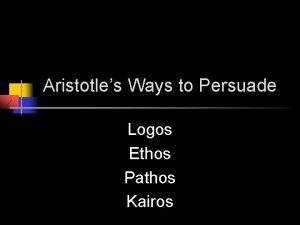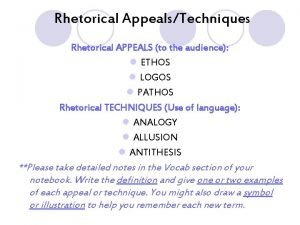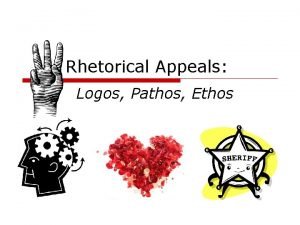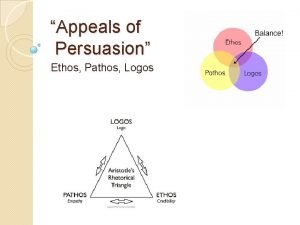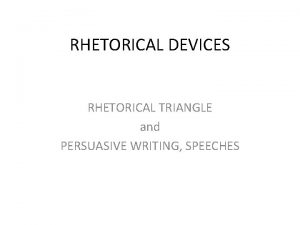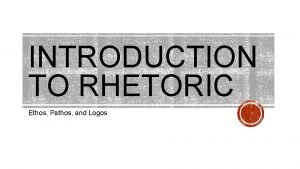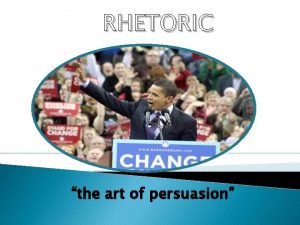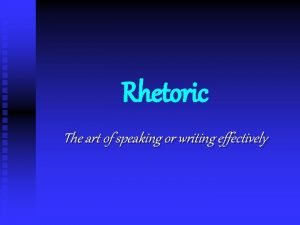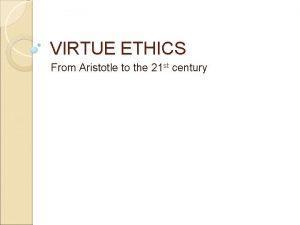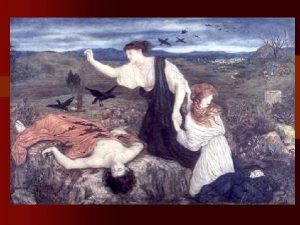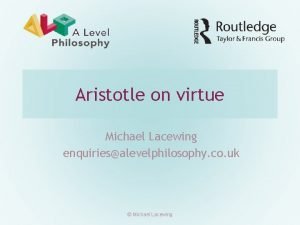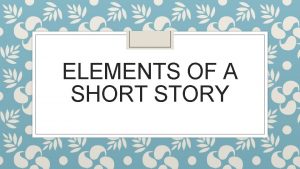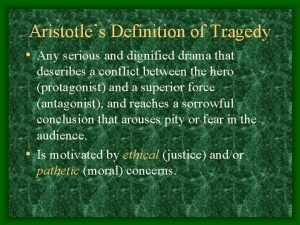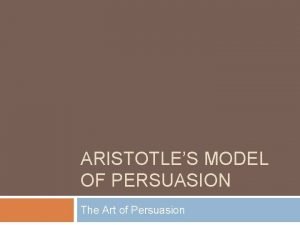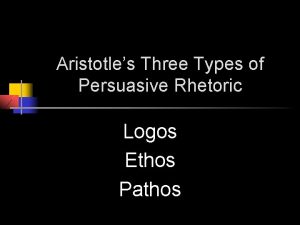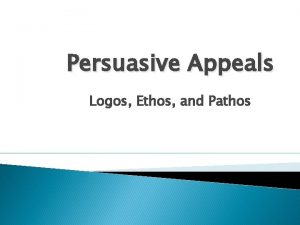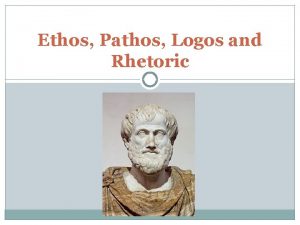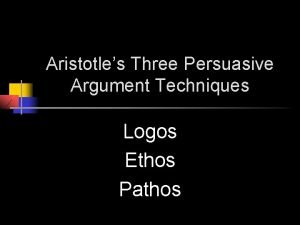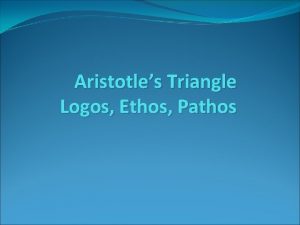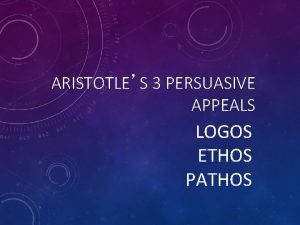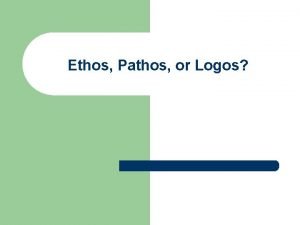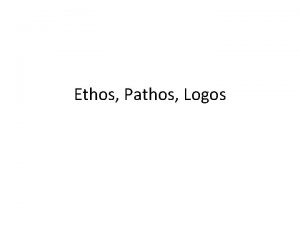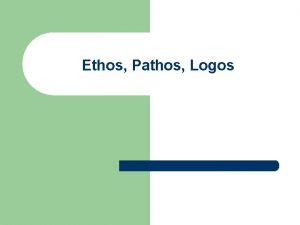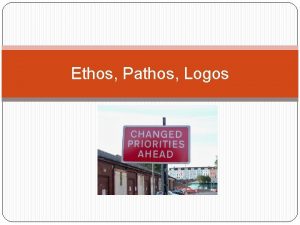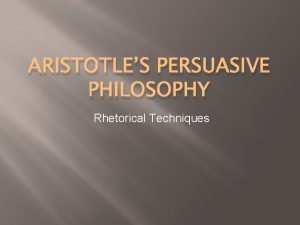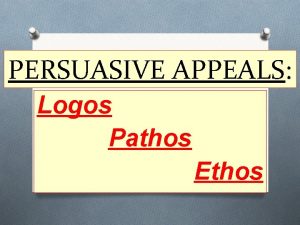Aristotles Three Types of Persuasive Rhetoric Logos Ethos








![Bernie Sanders n “[The] middle -- the family right in the middle of the Bernie Sanders n “[The] middle -- the family right in the middle of the](https://slidetodoc.com/presentation_image_h2/ea749b2d34afec34a7cd0a9086d691c4/image-9.jpg)







- Slides: 16

Aristotle’s Three Types of Persuasive Rhetoric Logos Ethos Pathos

What is rhetoric? Rhetoric is the skillful use of language. The goal of persuasion is to change others’ point of view or to move others to take action. Precise, thoughtful, purposeful language and images are tools for persuasion/argument.

What are logos, ethos, and pathos? Logos = Logic Ethos = Ethics, Image Pathos = Emotions (Passion)

The rhetorical triangle is typically represented by an equilateral triangle, suggesting that logos, ethos, and pathos should be balanced within a text. However, which aspect(s) of the rhetorical triangle you favor in your writing depends on both the audience and the purpose of that writing. Yet, if you are in doubt, seek a balance among all three elements. Logos (reason/text) Ethos (credibility/writer) Pathos (values, emotions, audience)

Logos is an argument based on facts, evidence and reason. Using logos means appealing to the readers’ sense of what is logical. Logos appeals to reason. Logos can also be thought of as the text of the argument, as well as how well a writer has argued his/her point.

Ethos is an argument based on character. Using ethos means the writer or speaker appeals to the audience’s sense of ethical behavior. The writer or speaker presents him or herself to the audience as credible, trustworthy, honest and ethical. Ethos can also be thought of as the role of the writer in the argument, and how credible his/her argument is. “I am an ethical expert, so believe what I say. ”

Pathos = argument based on feelings Pathos appeals to the emotions and the sympathetic imagination, as well as to beliefs and values. Pathos can also be thought of as the role of the audience in the argument.

Logos
![Bernie Sanders n The middle the family right in the middle of the Bernie Sanders n “[The] middle -- the family right in the middle of the](https://slidetodoc.com/presentation_image_h2/ea749b2d34afec34a7cd0a9086d691c4/image-9.jpg)
Bernie Sanders n “[The] middle -- the family right in the middle of the economy would pay $500 dollars more in taxes, and get a reduction in their healthcare costs of $5, 000 dollars. ”

Ethos

H. Clinton n “So we have a special obligation to make clear what we stand for, which is why I think we should not make promises we can't keep, because that will further, I think, alienate Americans from understanding and believing we can together make some real changes in people's lives. ”

Pathos

n “Free trade Is terrible. Free trade can be wonderful if you have smart people. But we have stupid (in office). ” - Donald Trump

The rhetorical triangle is typically represented by an equilateral triangle, suggesting that logos, ethos, and pathos should be balanced within a text. However, which aspect(s) of the rhetorical triangle you favor in your writing depends on both the audience and the purpose of that writing. Yet, if you are in doubt, seek a balance among all three elements. Logos (reason/text) Ethos (credibility/writer) Pathos (values, emotions, audience)

Analyzing Logos: Is thesis clear and specific? Is thesis supported by strong reasons and credible evidence? Is the argument logical and arranged in a well-reasoned order? Ethos: What are the writer’s qualifications? How has the writer connected him/herself to the topic being discussed? Does the writer demonstrate respect for multiple viewpoints by using sources in the text? Are sources credible? Are sources documented appropriately? Does the writer use a tone that is suitable for the audience/purpose? Is the diction (word choice) used appropriate for the audience/purpose? Is the document presented in a polished and professional manner? Pathos: Are vivid examples, details and images used to engage the reader’s emotions and imagination? Does the writer appeal to the values and beliefs of the reader by using examples readers can relate to or care about?

 Pathos and kairos
Pathos and kairos Rhetorical advertisement
Rhetorical advertisement Ethos
Ethos Appeals of persuasion
Appeals of persuasion Whats a rhetorical triangle
Whats a rhetorical triangle Ethos definition literature
Ethos definition literature Ethos rhetoric
Ethos rhetoric Anecdote ethos pathos logos
Anecdote ethos pathos logos Rhetoric: the art of persuasive writing and public speaking
Rhetoric: the art of persuasive writing and public speaking Art of speaking and writing
Art of speaking and writing Rosalind hursthouse
Rosalind hursthouse Qualities of a tragic hero
Qualities of a tragic hero What were aristotle's virtues
What were aristotle's virtues Aristotles unities
Aristotles unities Megalopsychia tragedy definition
Megalopsychia tragedy definition Aristotelian tragedy meaning
Aristotelian tragedy meaning Aristotle's persuasion model
Aristotle's persuasion model
